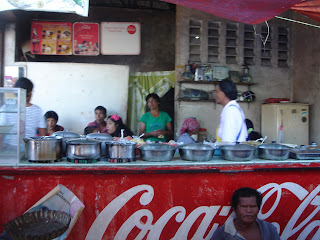Gone are the days when we, Cebuanos, need an expensive plane ticket or a cruise ship ride in order to experience an unforgettable cultural food trip. Our beloved Cebu, being a province of 508,844 hectares in land area, is blessed with 44 diverse municipalities each furnished with a unique culture of their own. Of those 44 towns is Argao, which is approximately 68 kilometers southeast of Cebu City or simply an 83-peso air-conditioned bus ride from the Cebu South Bus Terminal. Students, having the privilege of getting 15% off the original fare, only get to pay approximately Php70.
 |
| A friendly reminder inside a Ceres bus |
True enough, it gets boring once you board the bus since it passes by six towns namely Talisay City, Minglanilla, Naga City, San Fernando, Carcar City, and Sibonga before reaching Argao. During that long two hour ride, passengers are entertained by the songs played on the stereo or the movies shown on the TV screen. In the absence of these, food usually accompanies the passengers especially those who are traveling alone and are tired of watching the patches of green pass by their windows. For those who don’t like bringing their own snacks, there are peddlers from various towns who hop in and out of the bus selling water and finger food like cooked peanuts, chicharon (fried pork rinds), ampao (rice crispies), and colorful bukayos (sweet young coconut). One should not get too distracted by the food or the movies though because he might go past his destination, instead, he should learn to read the signs on the road to keep track of his whereabouts.
It is hard to get past Argao because the conductors of the bus usually announce your arrival and big tarpaulins with sayings in the Cebuano dialect serve as a welcome banner and reminder that the bus has reached the borders of the town. It is undeniable that there's this special aura felt once you step foot in Argao especially if you happen to arrive at the tricycle-flocked bus stop near the place they call the "eskina". The eskina is a block beside the national road with commercial establishments like salons, pharmacies, carenderias, bakeshops, and various food stalls lined up in a row. Through the dominating food-related one-level establishments and stores squeezed next to each other, you can immediately conclude that the Argaoanons love food and that food is not only a part of Argao's culture but it was, is, and will be integrated into the Argaoanon's way of life.
 |
| One side of the eskina |
Some of the elder locals say that even during the era of colonization, Argaoanons already had that fond for food which was visible on how they, even without the use of machines, patiently produced their delicious delicacies. Since it has been an Argaoanon tradition to hand out boxes of torta to visitors during fiestas and delicacy shops were not available then, each household had to produce their own torta. My 91 year old great grandmother, Felipa Saura, being one of the workhorses of torta production during the 1950's, stated that the torta they used to make is very much different from the modern cake-like version sold today. The original torta a la Argao was produced by beating egg yolks in a big bowl using a batirol or a manual mixer, then mixing the egg batter and flour mixture in a plangana or a wooden bowl, and later on leaving the torta molds filled with batter in makeshift clay ovens called hudno. Indeed, patience was tested in making this delicacy since the batter was so fragile that it had to be cooked right away once it rises or else it will taste sour and be put to waste. Lina or undyed tuba was one of the secret ingredients which gave the original torta the tangy taste.
Before the existence of popular alcoholic drinks like The Bar, San Miguel Beer, and Redhorse, tuba, which was fermented coconut juice, was the favorite local wine of the Argaoanons. The fermentation took place from a day up to a year which produced different classes of tuba namely the dawat, bahal, bahalina, and tinuig. The favorite viand of Argao, the braised pork belly or humba, was similar to the torta and tuba since it was also stored in kalderos or big pots overnight to produce a sour yet pleasing taste. Even until now the Argaoanon expression, "Mas magkabahaw, mas magkalami." (The longer it's stored, the tastier it gets.) is not only commonly said but also widely practiced.
 |
| My great grandmother, Lola Epang |
Before the existence of popular alcoholic drinks like The Bar, San Miguel Beer, and Redhorse, tuba, which was fermented coconut juice, was the favorite local wine of the Argaoanons. The fermentation took place from a day up to a year which produced different classes of tuba namely the dawat, bahal, bahalina, and tinuig. The favorite viand of Argao, the braised pork belly or humba, was similar to the torta and tuba since it was also stored in kalderos or big pots overnight to produce a sour yet pleasing taste. Even until now the Argaoanon expression, "Mas magkabahaw, mas magkalami." (The longer it's stored, the tastier it gets.) is not only commonly said but also widely practiced.
Recipes may have changed over the years but the fact that food was and still is a source of livelihood for many Argaoanons is unquestionable. Early morning, even before the big bright yellow sun comes out from its nest, Nang Hile, as what everyone calls her, struts around the streets of Argao bringing with her a black pail full of fresh fish that her husband, a fisherman, has caught a few hours before. This is what they have been doing for the past twenty years as a source of livelihood. Nang Hile has been in this business for so long that she takes only two rounds around the town; first, at early morning when she tries to sell all her fishes to her loyal customers and second, at night time when she collects the payments from her customers for the purchases done earlier. She has trust in her customers and in return, they believe in the quality and quantity of the fishes she sells. This kind of livelihood is present throughout the town since there are about a hundred fishermen who spend their dawns at sea just to catch fish and fish vendors that spend the whole day strolling around town and marketing their seafood.
 |
| Nang Hile on the right |
Vegetables, fruits, and root crops are also available in the public market thanks to humble vendors who have come a long way from the far mountainous areas of Argao. Despite the long rocky roads they had to pass through every early morning, these vendors never stopped bringing their wholesome vegetables to the town in order for them to earn a living. This kind of humble business has been helping vendors send their children to school. In Argao, native delicacies never went to the grave because puto, bibingka, biko, and the like are sold fresh and hot every morning in some of the stalls and kafes near the eskina.
 |
| Fruit stands at the Argao Public Market |
At lunch time, carenderias own the food business with newly cooked staple rice paired with aromatic fish, meat, and vegetable viands. There are numerous carenderias in every corner of the town yet at the end of the day, no food goes to waste since these carenderias have students, tricycle drivers, and workers as their suki or valuable customers. I've always wondered why customers come back and forth to these carenderias and I tried asking a local named Rhea Mae and she answered, "Di mahal ya lami pajud." (It's not expensive plus it's delicious.) The carenderias that are open day and night in Argao are mass-oriented since the food are not only affordable but also delicious and worth the money. The quality ingredients and handed-down recipes form a great combination that makes you want to come back for more.
One thing that Argaoanons never get tired of is street food. At around 3 pm or early afternoon, carts and stalls begin to come out in the open as students go home from a long day at school. These carts and stalls sell street food like kwek-kwek (quail egg in orange batter), tempura, squid balls, bananacue, and barbecue which serve as meriendas or afternoon snacks. Over the years, these street food have become the all-time favorite of Filipinos everywhere and the source of extra income for many.
 |
| A carenderia in the Argao Public Market |
One thing that Argaoanons never get tired of is street food. At around 3 pm or early afternoon, carts and stalls begin to come out in the open as students go home from a long day at school. These carts and stalls sell street food like kwek-kwek (quail egg in orange batter), tempura, squid balls, bananacue, and barbecue which serve as meriendas or afternoon snacks. Over the years, these street food have become the all-time favorite of Filipinos everywhere and the source of extra income for many.
 |
| Kwek-kwek cart |
It is in the nature of the Filipinos, without the exemption of the Argaoanons, to go with the flow and the status quo. That's why although we have our favorites, it is always prone to change. Over time, with the influx of Western influences, the taste of the Argaoanons has somehow changed. While branded bakeshops like Julie's, Arbee's, and Lolo Tinong's are competing against each other, the then-famous Argao Bakeshop is slowly becoming a fading mini-mart with less customers because of the abundance of marts. In the eskina, a branch of Orange Brutus is slowly killing the sales of the adjacent Big Mac which was the most in demand burger place nine years ago. Inside the Argao Public Market, old halo-halo stalls are closing down because of the opening of air-conditioned pizza parlors that offer milkshakes, fries, and ice cream. Sad to say, the food places people used to enjoy years ago are shutting down and are paving way for the new Western-influenced food industry. But this should not be seen as a really negative note since everyone should be open-minded enough to accept changes or else nothing will happen. This is just one of the proofs that food is connected to an Argaoanon's lifestyle because as the lifestyles of the Argaoanons change, their attitude and interest towards the different kinds of food change as well.
Sources:
Facts and Figures. Cebu Provincial Government. October 13, 2011
http://www.cebu.gov.ph/about/facts-and-figures/
Ravire, M. 6 Things Argao is Famous For. Free Article Directory. October 13, 2011
http://www.articlesnatch.com/Article/6-Things-Argao-Is-Famous-For/912943]
Personal interview. Deguil, Rhea Mae. October 15, 2011.
Personal interview. Saura, Felipa. October 25, 2011.
*All photos taken by me
 |
| Momma's Pizza Parlor |
 |
| The Argao Bakeshop |
Facts and Figures. Cebu Provincial Government. October 13, 2011
http://www.cebu.gov.ph/about/facts-and-figures/
Ravire, M. 6 Things Argao is Famous For. Free Article Directory. October 13, 2011
http://www.articlesnatch.com/Article/6-Things-Argao-Is-Famous-For/912943]
Personal interview. Deguil, Rhea Mae. October 15, 2011.
Personal interview. Saura, Felipa. October 25, 2011.
*All photos taken by me
